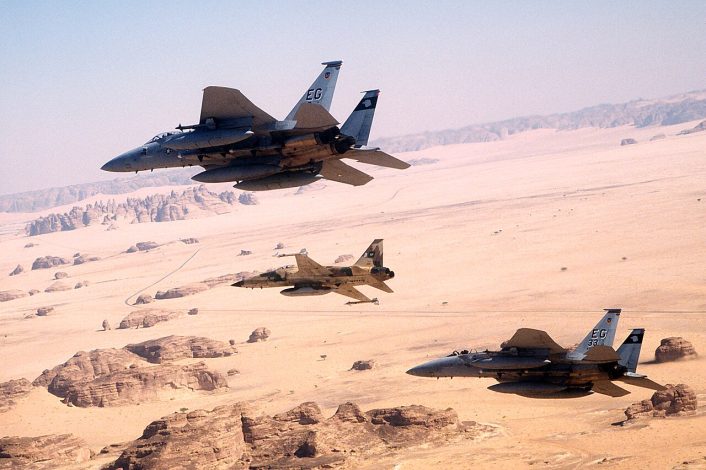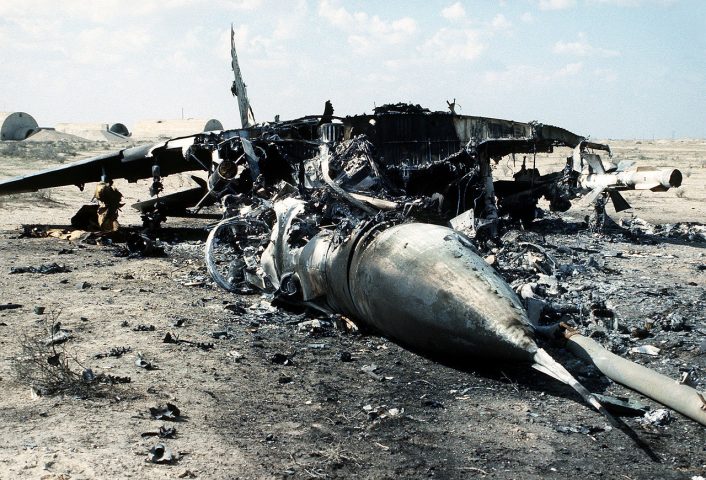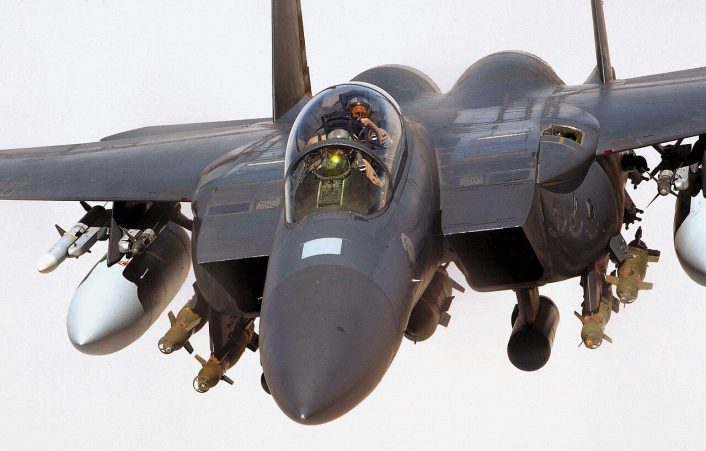Iraq’s invasion of its neighbor Kuwait on Aug. 2, 1990, caused an international coalition to respond with Operation Desert Shield, eventually culminating in the Coalition forces taking control of the skies in Operation Desert Storm.
With elite Iraqi Republican Guards near the Saudi Arabian border in Kuwait poised to drive south into Saudi Arabia, an immediate response was required to dissuade such an action. United States Air Force (USAF) aircraft arrived within days of the invasion. F-15C Eagles and F-15E Strike Eagles were the first to arrive, with the F-15C eventually becoming the most deadly air-superiority fighter in the skies during the Gulf War (Operation Desert Storm).
First on Scene
Two USAF squadrons of F-15 Eagles from Langley Air Force Base (AFB), Virginia, arrived in Saudi Arabia on Aug. 7, 1990, in response to the Iraqi aggression and perceived threat to Saudi oil fields. A total of 27 aircraft arrived fully armed at Dhahran Air Base (AB) in Saudi Arabia, with 25 more arriving the second day, bringing the total to 52 Eagles in only two days.
F-15E Strike Eagles, the precision strike/attack variant of the F-15, arrived on Aug. 9, and, by Aug. 11, there were a total of 12 F-15Es on alert carrying Rockeye area munitions (cluster bombs) that could release hundreds of small bomblets over a large area. A highly effective anti-personnel weapon as well as destructive against lightly armored targets, the Rockeye armed F-15Es were a strong deterrence against any Iraqi troop movements into Saudi territory.

A massive buildup of military forces soon followed consisting of multiple nations forming an international coalition against Saddam Hussein and his invasion of Kuwait. Among those resources pouring into the region were more F-15s, with a total of approximately 120 F-15C/D models and 48 F-15Es. Soon the build-up known as Operation Desert Shield would become a campaign known as Operation Desert Storm, with the F-15C/D models immediately going to work neutralizing the Iraqi Air Force in Kuwait.
The F-15C/D
The first F-15A flight took place in July of 1972. The single-seat F-15C and two-seat F-15D aircraft began entering the inventory of the USAF in 1979. The F-15C was designed from the outset to achieve air supremacy with powerful radar, impressive thrust and maneuverability, and a bubble canopy for greater visibility. The Eagle could engage enemy aircraft beyond visual range (BVR), or in close quarters combat. The F-15D variant is a trainer with full combat capability.

A product of McDonnell Douglas (Boeing), the F-15C of the Gulf War was powered by two Pratt & Whitney F100-PW-220 turbofan engines providing 23,770 lb of thrust each, giving the aircraft a combat thrust-to-weight ratio of 1.3:1. This high thrust-to-weight ratio allows for unprecedented maneuverability and high speeds. The maximum speed of the F-15C is Mach 2.5.
The F-15C’s primary armament during the war was the AIM-7 Sparrow radar-guided air-to-air missile (AAM) that has a range of up to 35 miles. Four of the Sparrows are usually carried, along with four AIM-9 Sidewinder heat-seeking missiles for closer engagements. Rounding out the weaponry the F-15C could bring to bear in air-to-air combat was a General Electric M61 rotating barrel cannon mounted in the starboard wing root, supplied with 940 rounds of 20 mm ammunition from a fuselage-mounted drum magazine.

The AN/APG-63 pulse-Doppler radar that equipped the F-15C employed a high pulse repetition frequency (PRF) allowing the tracking of targets in ground clutter utilizing Doppler shift, and used a medium PRF to obtain data for weapons employment. The Eagle could track targets at different ranges, speeds, and altitudes. The AN/APG-63 allowed for the detection of fighter-size targets in a ‘look up’ environment out to approximately 93 miles with a ‘look down’ range of about half that. Contacts could also be determined using a built-in identification friend or foe (IFF) interrogator to distinguish friendly and hostile aircraft.
The F-15C utilizes Non-Cooperative Target Recognition (NCTR) which receives radar returns from a target’s engine fan and compares it to data stored in the Eagle’s onboard library. This allows for the aircraft type to be identified and displayed.
Computers would process the radar interpretations and generate symbols on the pilot’s display. Software filters eliminated the clutter allowing the pilot to see only the echoes from other aircraft. Data useful for the pilot for the weapon selected was computed such as the target’s altitude, airspeed, heading, and closure rate among others, presenting the information that could be interpreted instantly.
Immediate Success
In the darkness of the early hours of Jan. 17, 1991, after all diplomatic efforts had been exhausted and while the electronic eyes , ears and communication systems of the Iraqi forces were being systematically dismantled by AH-64 Apache helicopter gunships, F-117 Nighthawks, Boeing B-52 bombers, Tomahawk cruise missiles, F-15Es and other weapons platforms of the Coalition, the F-15C went to work dismantling the Iraqi Air Force (IQAF) and working towards air superiority.
The IQAF was a respectable force, at least on paper, with over 700 combat aircraft — including French-built Mirage F1s, Soviet era Mikoyan-Gurevich MiG-23s, MiG-21s, MiG-25s, MiG-29s Sukhoi Su-20/22s, Su-25s, Su-24s, and Tupolev Tu-22s and Tu-16s. The MiG-25s, MiG-29s, and Mirage F1s were regarded as the most significant threats to air superiority. Soviet-designed helicopters and transports were also in prevalent use.

USAF Capitan Jon Kelk would draw blood early on the first night of the campaign, with the initial air-to-air kill for the Coalition downing an Iraqi MiG-29 while flying with the 33rd Tactical Fighter Wing (TFW) in an F-15C. It would also be the first recorded American kill in an F-15. Kelk destroyed the MiG as he closed his eyes to protect them from the flash of the launch of the AIM-7 Sparrow in the darkness and then witnessed the MiG explode as a violet flaming torch in the distant sky.
The Iraqi MiG-29 was at a disadvantage being equipped with limited BVR capabilities and with poor look-down/shoot-down capability as well. However, the Mig-29 was a worthy opponent at closer ranges, being highly maneuverable and it had the ability to fire short-range missiles with the aid of a helmet-mounted monocle sight and utilized a passive infra-red search that could determine targets without tipping off electronic radar warning equipment. This made the superior BVR capabilities of the F-15C an important tool in achieving air superiority.

On Jan. 19, USAF F-15C pilot Cesar ‘Rico’ Rodriguez downed a MiG-29 after engaging it in a descending scissors pattern with both pilots attempting to gain the advantage of a superior firing position. Rodriquez attempted to get a lock with an AIM-9 Sidewinder, but the heat of the approaching desert floor interfered with the heat-seeking missile. He was too close for radar-guided missiles, so as he considered switching to guns, the Iraqi pilot made a mistake at 1,000 ft by inverting and pulling down in an attempt to escape with not enough room to pull out of the dive. Rodriguez had maneuvered the MiG into the ground.
Rodriguez, unknowingly flying the exact same aircraft (85-0114), a week later fired an AIM-7 Sparrow at an approaching flight of MiG-23s. His missile and another from a member of his flight both struck home head-on, each downing a MiG. Rodriguez didn’t realize he was flying the same aircraft as he was during his first kill until he noticed the crew chiefs applying the kill markings under the canopy rail. His aircraft is now on display at the Smithsonian’s Steven F. Udvar-Hazy Center in Chantilly, Virginia.
Rodriguez would go on to down yet another MiG-29 in a different F-15C, this time a Yugoslavian aircraft during Operation Allied Force. The new AIM-120 missile was used, recording one of the first kills for that weapon. Since the Vietnam War, only three other USAF pilots have come this close to the mark of ‘ace’, which requires a total of five victories. Rodriguez served with the 33rd TFW 58th Tactical Fighter Squadron (TFS).

Although the IQAF appeared well-equipped and was staffed with battle-hardened veterans of the lengthy war with Iran, the F-15C drivers claimed six victories the first night of the campaign, and accounted for 35 of the 39 (some sources state 34 of 37) total Coalition air-to-air victories during Operation Desert Strom. Within three days air superiority was accomplished, with much of the IQAF aircraft either retreating towards Iran or being shot down in route, with some being interned by the Iranians if they did survive the F-15C gauntlet. Others were placed in hardened shelters only to be destroyed by Coalition precision bombing by the likes of the F-117. No F-15Cs were lost to air-to-air action. The 33rd TFW’s 58th TFS was the highest scoring unit of the war credited with 16 victories.
The list of victims of the Eagle during Desert Storm include five MiG-29s, six Mirage F1s, two MiG-25s, eight MiG-23s, two MiG-21s, two Su-25s, four Su-22s, one Su-7, one Il-76 transport, a Pilatus PC-9 trainer, and a pair of Mil Mi-8 helicopters. Royal Saudi Air Force (RSAF) F-15Cs contributed shooting down two Iraqi Mirage F1s as well.

The F-15E also got in on the air-to-air action, recording the type’s first kill when a Strike Eagle dropped a GBU-10 laser-guided bomb on an in-flight Iraqi Mil Mi 24 ‘Hind’ helicopter, destroying it on Feb. 14.
Despite rumors producing little or no solid evidence to the contrary, F-15s have compiled a record of 104 kills to no losses in air-to-air action. Israeli pilots have achieved over half of the F-15’s recorded kills.









